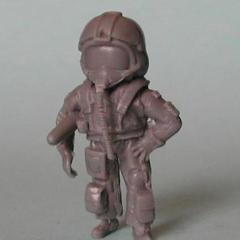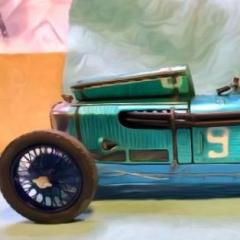-
Posts
149 -
Joined
-
Last visited
Pg265's Achievements

MCM Friend (4/6)
-
Good evening, A big thank you to everyone! I am really delighted that you liked this build. It was a real pleasure for me as the kit is beautiful and the McLaren sublime. Here are the latest images of the Rooaaring Papaya. The base was quickly made for an exhibition, as was the transport box, which also became his new home. Pascal🟠
-
Good evening, I decided to make a small plate (to "energize" the presentation of the Mc Laren. At the beginning of the start of the departure…, we have this: A small sheet of aluminum and a bit of laminated carbon. A line of Papaya to be in the theme, some decals and a touch of varnish later That was for the plate. Regarding the automobile, we start with the rear wing’s arms. They are primed then painted black. The Dzus are installed on the muzzle: A layer of matte black Tamiya is spayed freehand inside the two noses to make the background uniform. A final view of the elements before the installation of the fin: The white and black rivets are placed on the race numbers and the fin is permanently fixed... remains a bit of cleaning…, but we can call this one done! Some images: Still need to prepare: - a transport box that will also be the new home of the M19. - a base to present it. Last pictures on its base and with its plate soon. Pascal🟠
-
Good evening, Thank you very much!😉 @iBorg: The kit is from Model Factory Hiro, rivets are 0.4 flat spherical resin rivets from Master Club. The alignment is not that difficult due to the engraved locations on the body parts. The air box is now ready to receive its decals. The 'HULME' is more complicated than it seems to install. I redid the two triangular plates for attaching the engine to the hull. They are cut from a 1/10th mm thick aluminum sheet, drilled, the angles are made with diamond file. I also added magnets behind the false central hubs in order to always have access to the wheel mounting screws. She is not that bad-looking either with the 'big nose'. A big karting!... A small cleaning will precede the installation of the last rivets. The installation of the aileron and bolts of the new engine plates should conclude this assembly. Never been so close to the end!… Pascal🟠
-
Hello, A small inconvenience with the Micro Sol (it started to dilute the paint!!!) made the appearance of the engine air scoop perfectible in my eyes. Being the happy owner of a second decal sheet, I decided to take it all back...🙄 The air scoop is completely stripped. Then primed (GC Dark Surface Primer). .... and finally receives its color: Phtalo Cyanine Blue (Mister Hobby) I am thinking of varnishing it before setting up the decals. Pascal🟠
-
Good evening, Nature doesn’t like emptiness... neither does my rear wing! Initially hesitant, then finally unable to bring myself to leave him naked... I decided to rivet him. The fin is assembled. All that remains is to fix the ties that link it to the box. The fixing tabs of the air box holding springs are glued on the valve covers: a poem... The links of the rear anti-roll bar are also in place. The tires have received their Good Year marking. Pascal 🟠
-
Hello, Thanks a lot! Busy Sunday (🛩️🏎️)... but some progress nonetheless. I take advantage of my topic, quite timely, to congratulate McLaren and celebrate its 10th constructors' world title!!!🏆🥇 I took care of the snouts. - The varnished fins yesterday were decorated, detailed and installed for good on the nose. - the extractor, varnished yesterday too, receives its Gulf and is set up for the positioning of the race number. The small Gulf / checkered finalize this large element. The inside of the 2 noses is painted in matte black. The decals are placed on the parts of the rear wing. It should not take long to be assembled. More soon. Pascal🟠
-
Good evening, Thank you!😉 Bad weather this morning, great to continue the build. A little primer to start: - The upper blade of the rear fin, - the extractor for the test snout, - the rivets - and the whiskers of the racing version. Then a little bit of McLaren Orange. Decided to take care of the wheels, I made tools to improve the appearance of the tires. Two diameters allow to treat the front and the back. The rims are then equipped - valves, - tire locking bolts on the rim, - some balancing weights. I adjusted the diameter of the part intended for sanding the tires to that of the inner diameter of the rims by 3 mm. This allowed me to form the 'balancing weights (taken from the photo-etching plate) after having 'annealed' them. I plan to put a little Duck Tape on it. A washer is also installed under the valves. I will try to take better photos... the hubs are a bit worked, drilled, polished, the inner diameter reamed. The nut is painted in satin black, diluted enough to let the bright edges show; this gives a more 'operational' aspect. The pin is installed in the previously drilled holes and an oil wash completes this step. The (temporary) assembly of the wheels on the car allows checking the ride height, the attitude (it reminds me of last night’s « Mécanique du vol » class...) and the symmetry. Shims are machined to relieve the efforts due to the weight, consequent(!!) of the model. The clear coat of the earlier painted elements dries quietly. I took the opportunity to varnish the body of the Alfa 155V6TI DTM. More very soon. Pascal🟠
-
Good evening, The build is still progressing. The A/N fittings are installed on the oil tank: a bit of color… I machined a brass plug for the unused outlet. The exhausts are in place. The tank, the box end, the fin mast, and the battery are also installed. The radiator block and its hoses should not be long... ...There they are! Oil pressure OK! The pipes now connect the engine to the tank. The battery is connected and the tie rods are installed. The stabilizer bar is in place; there are still the links to assemble. The brakes will be better cooled thanks to their scoops. The wheels are starting to take shape. The veil/center is colored by chemical dipping. Overview. More progress soon.😉 Pascal🟠
-
Good evening, A little work on the electric fuel pump, on the connections. ...and quite a bit of other small preparation work on subsets... The fittings and fuel lines are in place, the mechanical pump is installed on the engine. Still completing the back of the shell Then finally comes the time to fix the engine block on it! With some « clothes ». More very soon. Pascal🟠
-
Good evening, The front drivetrain is mounted, steering installed and brakes connected. Adjustment and small adaptations to make the screw heads flush. A little acid (burnisher) to darken the brass of the tie rods. I started to work on the back of the shell in order to quickly install and connect the DFV. The gearbox should quickly follow! The wheels are also in progress. Pascal🟠
-
Hello, Progressing slowly, but surely. The right mirror is finished then installed and riveted to the top body. He asked me to do some work with a soft file, then it was polished with paste. The upper part of the shell has finally been glued to the chassis. The work done upstream allows a rather precise adjustment, in order to obtain a very fine junction: the upper part of the shell was riveted on the lower part. The hull decoration is then applied: more delicate than it seems, but I expected it for the white circles: not so easy to make the decal conform to the beautiful curves (on all axis) of the pontoons. Solvent and heater helped me a lot! Here are some pictures: More soon. Pascal🟠
-
Good evening, Thank you, gentlemen.😉 Some progress on the ROOOAAARING PAPAYA. The wide muzzle of the trials is in progress: Flaps, Duck tape, Dzus... It remains to paint the extractor and put the race number. The flaps are riveted: stainless steel rivets flat head 0.4. Mirrors require a bit of work especially since, too enthusiastic (🙄), I broke through one from start to finish... Repaired by welding, it is then improved with a soft file, sanded then polished. One finished compared to the other raw. I also decided to install there, for more realism and especially to please myself, «real» mirrors. The windshield is now riveted and small washers feature the fastenings inside the cockpit. The left rear-view mirror is mounted on its folded photo-etched support. The support is drilled and, also, equipped with stainless steel rivets. These same rivets are installed on the upper part of the back of the shell. The right side is waiting for its turn and the locations are properly cleared of paint. Some decals are placed: The KIWI is here!! The cooling pipes are treated in the same way as those on the right and then installed. The connecting tubes to the engine have also been prepared. A test confirms the proper alignment of the engine, air box and hoop. More soon. Pascal🟠





